Thermochemical Liquefaction as a Cleaner and Efficient Route for Valuing Pinewood Residues from Forest Fires
Abstract
1. Introduction
2. Materials and Methods
2.1. Liquefaction Procedure
2.2. Fourier Transformed Infrared (FTIR-ATR) Analysis of Biomass and Bio-Oil
2.3. Elemental Analysis and Higher Heating Value (HHV)
2.4. Thermogravimetric Analysis (TGA)
3. Results and Discussion
3.1. Chemical Characterisation of Biomass Feedstock
3.2. Biomass Liquefaction
3.3. FTIR-ATR Analysis for the Biomass and Bio-Oils
3.4. Elemental Analysis and HHV Calculation of the Bio-Oils
3.5. Thermogravimetric Analysis of the Biomass and Bio-Oils
4. Conclusions
Author Contributions
Funding
Acknowledgments
Conflicts of Interest
Sample Availability
References
- Hosonuma, N.; Herold, M.; De Sy, V.; De Fries, R.S.; Brockhaus, M.; Verchot, L.; Angelsen, A.; Romijn, E. An assessment of deforestation and forest degradation drivers in developing countries. Environ. Res. Lett. 2012, 7, 044009. [Google Scholar] [CrossRef]
- Bailis, R.; Wang, Y.; Drigo, R.; Ghilardi, A.; Masera, O. Getting the numbers right: Revisiting woodfuel sustainability in the developing world. Environ. Res. Lett. 2017, 12, 115002. [Google Scholar] [CrossRef]
- Zhang, Y.; Chen, W.-T. Hydrothermal liquefaction of protein-containing feedstocks. Direct Thermochem. Liq. Energy Appl. 2018, 7, 127–168. [Google Scholar] [CrossRef]
- Kržan, A.; Kunaver, M. Microwave heating in wood liquefaction. J. Appl. Polym. Sci. 2006, 101, 1051–1056. [Google Scholar] [CrossRef]
- Fernandes, F.; Matos, S.; Gaspar, D.; Silva, L.; Paulo, I.; Vieira, S.; Pinto, P.C.R.; Bordado, J.; dos Santos, R.G. Boosting the Higher Heating Value of Eucalyptus globulus via Thermochemical Liquefaction. Sustainability 2021, 13, 3717. [Google Scholar] [CrossRef]
- Condeço, J.A.; Hariharakrishnan, S.; Ofili, O.M.; Mateus, M.M.; Bordado, J.M.; Correia, M.J.N. Energetic valorisation of agricultural residues by solvent-based liquefaction. Biomass Bioenergy 2021, 147, 106003. [Google Scholar] [CrossRef]
- Abaide, E.R.; Ahmadzadeh, H.; Alzate, C.A.C.; Amiri, H.; Ang, G.T.; Avhad, M.R.; Biswas, N.; Burton, E.; Costa, J.A.V.; Da Silva, P.P.; et al. List of Contributors. In Advanced Bioprocessing for Alternative Fuels, Biobased Chemicals and Bioproducts; Hosseini, M., Ed.; Woodhead Publishing: Sawston, UK, 2019; pp. xv–xviii. [Google Scholar] [CrossRef]
- Xiu, S.; Shahbazi, A. Bio-oil production and upgrading research: A review. Renew. Sustain. Energy Rev. 2012, 16, 4406–4414. [Google Scholar] [CrossRef]
- Amado, M.; Bastos, D.; Gaspar, D.; Matos, S.; Vieira, S.; Bordado, J.M.; dos Santos, R.G. Thermochemical liquefaction of pinewood shaves—Evaluating the performance of cleaner and sustainable alternative solvents. J. Clean. Prod. 2021, 304, 127088. [Google Scholar] [CrossRef]
- Mateus, M.; Bordado, J.; dos Santos, R.G. Potential biofuel from liquefied cork—Higher heating value comparison. Fuel 2016, 174, 114–117. [Google Scholar] [CrossRef]
- dos Santos, R.G.; Bordado, J.; Mateus, M.M. Potential biofuels from liquefied industrial wastes—Preliminary evaluation of heats of combustion and van Krevelen correlations. J. Clean. Prod. 2016, 137, 195–199. [Google Scholar] [CrossRef]
- Zhang, H.; Pang, H.; Shi, J.; Fu, T.; Liao, B. Investigation of liquefied wood residues based on cellulose, hemicellulose, and lignin. J. Appl. Polym. Sci. 2012, 123, 850–856. [Google Scholar] [CrossRef]
- Mateus, M.; Guerreiro, D.; Ferreira, O.; Bordado, J.; dos Santos, R.G. Heuristic analysis of Eucalyptus globulus bark depolymerization via acid-liquefaction. Cellulose 2017, 24, 659–668. [Google Scholar] [CrossRef]
- Kunaver, M.; Jasiukaitytė, E.; Čuk, N. Ultrasonically assisted liquefaction of lignocellulosic materials. Bioresour. Technol. 2012, 103, 360–366. [Google Scholar] [CrossRef]
- Braz, A.; Mateus, M.M.; dos Santos, R.G.; Machado, R.; Bordado, J.M.; Correia, M.J.N. Modelling of pine wood sawdust thermochemical liquefaction. Biomass Bioenergy 2019, 120, 200–210. [Google Scholar] [CrossRef]
- Mateus, M.; Vale, M.; Rodrigues, A.; Bordado, J.; dos Santos, R.G. Is biomass liquefaction an option for the viability of poplar short rotation coppices? A preliminary experimental approach. Energy 2017, 124, 40–45. [Google Scholar] [CrossRef]
- Viana, R.E.H.; Dos Santos, S.G.; Oliveira, A.C.; Information, P.E.K.F.C. Recovery of resistant bacteria from mattresses of patients under contact precautions. Am. J. Infect. Control. 2015, 44, 465–469. [Google Scholar] [CrossRef]
- Soares, B.; Gama, N.; Freire, C.; Timmons, A.B.; Brandão, I.; Silva, R.; Neto, C.P.; Ferreira, A. Ecopolyol Production from Industrial Cork Powder via Acid Liquefaction Using Polyhydric Alcohols. ACS Sustain. Chem. Eng. 2014, 2, 846–854. [Google Scholar] [CrossRef]
- Soares, B.; Gama, N.; Freire, C.S.; Barros-Timmons, A.; Brandão, I.; Silva, R.; Neto, C.P.; Ferreira, A. Spent coffee grounds as a renewable source for ecopolyols production. J. Chem. Technol. Biotechnol. 2015, 90, 1480–1488. [Google Scholar] [CrossRef]
- Dos Santos, R.G.; Ventura, P.; Bordado, J.; Mateus, M. Direct and efficient liquefaction of potato peel into bio-oil. Environ. Chem. Lett. 2017, 15, 453–458. [Google Scholar] [CrossRef]
- Dos Santos, R.G.; Ventura, P.; Bordado, J.; Mateus, M. Valorizing potato peel waste: An overview of the latest publications. Rev. Environ. Sci. Bio Technol. 2016, 15, 585–592. [Google Scholar] [CrossRef]
- Wang, H.; Chen, H.-Z. A novel method of utilizing the biomass resource: Rapid liquefaction of wheat straw and preparation of biodegradable polyurethane foam (PUF). J. Chin. Inst. Chem. Eng. 2007, 38, 95–102. [Google Scholar] [CrossRef]
- Liang, L.; Mao, Z.; Li, Y.; Wan, C.; Wang, T.; Zhang, L.; Zhang, L. Liquefaction of crop residues for polyol production. Bioresources 2006, 1, 248–256. [Google Scholar] [CrossRef]
- dos Santos, R.G.; Carvalho, R.; Silva, E.R.; Bordado, J.; Cardoso, A.C.; Costa, M.D.R.; Mateus, M. Natural polymeric water-based adhesive from cork liquefaction. Ind. Crop. Prod. 2016, 84, 314–319. [Google Scholar] [CrossRef]
- Dos Santos, R.G.; Acero, N.F.; Matos, S.; Carvalho, R.; Vale, M.; Marques, A.C.; Bordado, J.C.; Mateus, M.M. One-Component Spray Polyurethane Foam from Liquefied Pinewood Polyols: Pursuing Eco-Friendly Materials. J. Polym. Environ. 2017, 26, 91–100. [Google Scholar] [CrossRef]
- Lee, S.-H.; Teramoto, Y.; Shiraishi, N. Biodegradable polyurethane foam from liquefied waste paper and its thermal stability, biodegradability, and genotoxicity. J. Appl. Polym. Sci. 2001, 83, 1482–1489. [Google Scholar] [CrossRef]
- Gama, N.V.; Soares, B.; Freire, C.S.; Silva, R.; Brandão, I.; Neto, C.P.; Barros-Timmons, A.; Ferreira, A. Rigid polyurethane foams derived from cork liquefied at atmospheric pressure. Polym. Int. 2015, 64, 250–257. [Google Scholar] [CrossRef]
- Vale, M.; Mateus, M.; dos Santos, R.G.; de Castro, C.N.; de Schrijver, A.; Bordado, J.C.; Marques, A.C. Replacement of petroleum-derived diols by sustainable biopolyols in one component polyurethane foams. J. Clean. Prod. 2019, 212, 1036–1043. [Google Scholar] [CrossRef]
- Seljak, T.; Oprešnik, S.R.; Kunaver, M.; Katrašnik, T. Wood, liquefied in polyhydroxy alcohols as a fuel for gas turbines. Appl. Energy 2012, 99, 40–49. [Google Scholar] [CrossRef]
- Mateus, M.; Gaspar, D.F.B.; Matos, S.; Rego, A.; Motta, C.; Castanheira, I.; Bordado, J.M.; dos Santos, R.G. Converting a residue from an edible source (Ceratonia siliqua L.) into a bio-oil. J. Environ. Chem. Eng. 2019, 7, 103004. [Google Scholar] [CrossRef]
- Mateus, M.; Carvalho, R.; Bordado, J.; dos Santos, R.G. Biomass acid-catalyzed liquefaction—Catalysts performance and polyhydric alcohol influence. Data Brief 2015, 5, 736–738. [Google Scholar] [CrossRef][Green Version]
- Li, Y.; Luo, X.; Hu, S. Lignocellulosic Biomass-Based Polyols for Polyurethane Applications; Springer: Singapore, 2015; pp. 45–64. [Google Scholar]
- Karagöz, S.; Bhaskar, T.; Muto, A.; Sakata, Y. Effect of Rb and Cs carbonates for Production of Phenols from liquefaction of wood biomass. Fuel 2004, 83, 2293–2299. [Google Scholar] [CrossRef]
- Oliveira, A.C.; Pereira, J.S.; Correia, A.V. A Silvicultura Do Pinheiro Bravo. 2000. ISBN: 972-98308-2-7. Available online: https://www.centropinus.org/files/upload/edicoes_tecnicas/7ca9c5bad087cc24e889debc852ec75fdf1c2143.pdf (accessed on 10 August 2021).
- Brasov, A.; Nicolescu, V.N. The Practice of Silviculture; Aldus: Seattle, WA, USA; ISBN 6069840100. Available online: https://books.google.pt/books?id=tFi4uQEACAAJ (accessed on 10 August 2021).
- Divisão de apoio à Gestão de Fogos Rurais. 8° Relatório Provisório de Incêndios Rurais; ICNF—SGIF: Lisboa, Portugal, 2020; Available online: https://www.icnf.pt/api/file/doc/7218b448c991d725 (accessed on 10 August 2021).
- Comissão Técnica Independente, Relatório Comunidade Independente—Análise e Apuramento dos Factos Relativos aos Incêndios que Ocorreram em Pedrogão Grande, Castanheiro de Pera, Ansião, Alvaiázere, Figueiró de Vinhos, Arganil, Góis, Penela, Pampilhosa da Serra, Oleiros e Sertã, entre. 2017. Available online: https://www.parlamento.pt/Documents/2017/Outubro/RelatórioCTI_VF.pdf (accessed on 10 August 2021).
- Beighley, M.; Hyde, A.C. Gestão dos Incêndios Florestais em Portugal numa Nova Era Avaliação dos Riscos de Incêndio, Recursos e Reformas. 2018. Available online: https://www.isa.ulisboa.pt/files/events/pub/2018_Portugal-Wildfire-Management-in-a-New-Era_Portuguese.pdf (accessed on 30 July 2021).
- U.S. National Park Service. Wildland Fire Spread and Suppression. 2015. Available online: https://www.nps.gov/articles/wildland-fire-spread-and-suppression.htm (accessed on 2 August 2021).
- Yang, Z.; Kumar, A.; Huhnke, R. Review of recent developments to improve storage and transportation stability of bio-oil. Renew. Sustain. Energy Rev. 2015, 50, 859–870. [Google Scholar] [CrossRef]
- UNECE/FAO. Annual Market Review 2019–2020—Forest Products; United Nations Publication: Geneva, Switzerland, 2020; Available online: https://unece.org/DAM/timber/publications/2020/SP-50.pdf (accessed on 16 August 2021).
- Barkley, Y.C. After the Burn: Assessing and Managing Your Forestland after a Wildfire, Moscow, Idaho. 2015. Available online: https://www.fs.usda.gov/rmrs/documents-and-media/after-burn-assessing-and-managing-your-forestland-after-wildfire (accessed on 2 August 2021).
- Johnson, F.X.; Pacini, H.; Smeets, E. Transformations in EU Biofuels Markets under the Renewable Energy Directive and the Implications for Land Use, Trade and Forests; Center for International Forestry Research: Bogor, Indonesia, 2012. [Google Scholar] [CrossRef][Green Version]
- Food and Agriculture Organization of the United Nations. Sustainable Forest Management (SFM) Toolbox; Wood Energy, (n.d.). Available online: http://www.fao.org/sustainable-forest-management/toolbox/modules/wood-energy/basic-knowledge/en/?type=111 (accessed on 2 August 2021).
- Sheng, C.; Azevedo, J. Estimating the higher heating value of biomass fuels from basic analysis data. Biomass Bioenergy 2005, 28, 499–507. [Google Scholar] [CrossRef]
- Yin, C.-Y. Prediction of higher heating values of biomass from proximate and ultimate analyses. Fuel 2011, 90, 1128–1132. [Google Scholar] [CrossRef]
- Mateus, M.M.; Bordado, J.M.; dos Santos, R.G. Estimation of higher heating value (HHV) of bio-oils from thermochemical liquefaction by linear correlation. Fuel 2021, 302, 121149. [Google Scholar] [CrossRef]
- Mullen, C.; Boateng, A.A. Chemical Composition of Bio-oils Produced by Fast Pyrolysis of Two Energy Crops. Energy Fuels 2008, 22, 2104–2109. [Google Scholar] [CrossRef]
- Ben, H.; Wu, F.; Wu, Z.; Han, G.; Jiang, W.; Ragauskas, A.J. A Comprehensive Characterization of Pyrolysis Oil from Softwood Barks. Polymers 2019, 11, 1387. [Google Scholar] [CrossRef]
- Oyebanji, J.; Okekunle, P.; Lasode, O.; Oyedepo, S. Chemical composition of bio-oils produced by fast pyrolysis of two energy biomass. Biofuels 2018, 9, 479–487. [Google Scholar] [CrossRef]
- Chukwuneke, J.; Ewulonu, C.; Chukwujike, I.; Okolie, P. Physico-chemical analysis of pyrolyzed bio-oil from swietenia macrophylla (mahogany) wood. Heliyon 2019, 5, e01790. [Google Scholar] [CrossRef]
- Tian, Y.; Wang, F.; Djandja, J.O.; Zhang, S.-L.; Xu, Y.-P.; Duan, P.-G. Hydrothermal liquefaction of crop straws: Effect of feedstock composition. Fuel 2020, 265, 116946. [Google Scholar] [CrossRef]
- Jindal, M.K.; Jha, M.K. Hydrothermal liquefaction of wood: A critical review. Rev. Chem. Eng. 2016, 31, 459–488. [Google Scholar] [CrossRef]
- Mateus, M.M.; Ventura, P.; Rego, A.; Motta, C.; Castanheira, I.; Bordado, J.; Dos Santos, R.G. Acid Liquefaction of Potato (Solanum tuberosum) and Sweet Potato (Ipomoea batatas) Cultivars Peels—Pre-Screening of Antioxidant Activity/Total Phenolic and Sugar Contents. Bioresources 2016, 12, 1463–1478. [Google Scholar] [CrossRef]
- Hassan, E.B.; Shukry, N. Polyhydric alcohol liquefaction of some lignocellulosic agricultural residues. Ind. Crop. Prod. 2008, 27, 33–38. [Google Scholar] [CrossRef]
- Pan, H.; Zheng, Z.; Hse, C.Y. Microwave-assisted liquefaction of wood with polyhydric alcohols and its application in preparation of polyurethane (PU) foams. Eur. J. Wood Wood Prod. 2012, 70, 461–470. [Google Scholar] [CrossRef]
- Rg, D.S.; Mm, B.J.M.; Jc, B. Microwave-assisted Liquefaction of Cork—From an Industrial Waste to Sustainable Chemicals. Ind. Eng. Manag. 2015, 4, 173–177. [Google Scholar] [CrossRef]
- Zhang, C.; Xu, W.; Yan, P.; Liu, X.; Zhang, Z.C. Overcome the recalcitrance of eucalyptus bark to enzymatic hydrolysis by concerted ionic liquid pretreatment. Process. Biochem. 2015, 50, 2208–2214. [Google Scholar] [CrossRef]
- Frankó, B.; Galbe, M.; Wallberg, O. Influence of bark on fuel ethanol production from steam-pretreated spruce. Biotechnol. Biofuels 2015, 8, 1–11. [Google Scholar] [CrossRef] [PubMed]
- Li, Z.; Lu, J.; Cao, J.; Jiang, J. Comparative Study of the Hydrothermal Softening Characteristics of Heartwood and Sapwood. For. Prod. J. 2020, 70, 243–248. [Google Scholar] [CrossRef]
- Mun, S.P.; Jang, J.P. Liquefaction of cellulose in the presence of phenol using p-toluene sulfonic acid as a catalyst. J. Ind. Eng. Chem. 2009, 15, 743–747. [Google Scholar] [CrossRef]
- Zhai, Q.; Long, F.; Hse, C.-Y.; Wang, F.; Shupe, T.F.; Jiang, J.; Xu, J. Facile Fractionation of Bamboo Wood Toward Biomass Valorization by p-TsOH-Based Methanolysis Pretreatment. ACS Sustain. Chem. Eng. 2019, 7, 19213–19224. [Google Scholar] [CrossRef]
- Grilc, M.; Likozar, B.; Levec, J. Kinetic model of homogeneous lignocellulosic biomass solvolysis in glycerol and imidazolium-based ionic liquids with subsequent heterogeneous hydrodeoxygenation over NiMo/Al2O3 catalyst. Catal. Today 2015, 256, 302–314. [Google Scholar] [CrossRef]
- Bui, N.Q.; Fongarland, P.; Rataboul, F.; Dartiguelongue, C.; Charon, N.; Vallée, C.; Essayem, N. FTIR as a simple tool to quantify unconverted lignin from chars in biomass liquefaction process: Application to SC ethanol liquefaction of pine wood. Fuel Process. Technol. 2015, 134, 378–386. [Google Scholar] [CrossRef]
- Zohdi, V.; Whelan, D.; Wood, B.R.; Pearson, J.; Bambery, K.; Black, M.J. Importance of Tissue Preparation Methods in FTIR Micro-Spectroscopical Analysis of Biological Tissues: ‘Traps for New Users’. PLoS ONE 2015, 10, e0116491. [Google Scholar] [CrossRef] [PubMed]
- Zhuang, J.; Li, M.; Pu, Y.; Ragauskas, A.J.; Yoo, C.G. Observation of Potential Contaminants in Processed Biomass Using Fourier Transform Infrared Spectroscopy. Appl. Sci. 2020, 10, 4345. [Google Scholar] [CrossRef]
- Popescu, C.-M.; Popescu, M.-C.; Singurel, G.; Vasile, C.; Argyropoulos, D.; Willför, S. Spectral Characterization of Eucalyptus Wood. Appl. Spectrosc. 2007, 61, 1168–1177. [Google Scholar] [CrossRef]
- Xu, F.; Yu, J.; Tesso, T.; Dowell, F.; Wang, D. Qualitative and quantitative analysis of lignocellulosic biomass using infrared techniques: A mini-review. Appl. Energy 2013, 104, 801–809. [Google Scholar] [CrossRef]
- Yona, A.M.C.; Budija, F.; Kričej, B.; Kutnar, A.; Pavlič, M.; Pori, P.; Tavzes, Č.; Petrič, M. Production of biomaterials from cork: Liquefaction in polyhydric alcohols at moderate temperatures. Ind. Crop. Prod. 2014, 54, 296–301. [Google Scholar] [CrossRef]
- ECN, Phyllis2-Database for the Physico-Chemical Composition of (Treated) Lignocellulosic Biomass, Micro and Macroalgae, Various Feedstocks for Biogas Production and Biochar. Energy Res. Cent. Neth. 2012. Available online: https://phyllis.nl/Browse/Standard/ECN-Phyllis#eucalyptus (accessed on 1 August 2021).
- Sadaka, S.; Boateng, A.A. Pyrolysis and Bio-Oil. Agric. Nat. Resour. 2009, 1, 1–6. Available online: https://www.uaex.uada.edu/publications/PDF/FSA-1052.pdf (accessed on 2 August 2021).
- Balat, M. Bio-Oil Production from Pyrolysis of Black Locust (Robinia pseudoacacia) Wood. Energy Explor. Exploit. 2010, 28, 173–186. [Google Scholar] [CrossRef]
- Lehto, J.; Oasmaa, A.; Solantausta, Y.; Kytö, M.; Chiaramonti, D. Review of fuel oil quality and combustion of fast pyrolysis bio-oils from lignocellulosic biomass. Appl. Energy 2014, 116, 178–190. [Google Scholar] [CrossRef]
- Lyu, G.; Wu, S.; Zhang, H. Estimation and Comparison of Bio-Oil Components from Different Pyrolysis Conditions. Front. Energy Res. 2015, 3, 28. [Google Scholar] [CrossRef]
- Rego, F.; Dias, A.P.S.; Casquilho, M.; Rosa, F.C.; Rodrigues, A. Fast determination of lignocellulosic composition of poplar biomass by thermogravimetry. Biomass Bioenergy 2019, 122, 375–380. [Google Scholar] [CrossRef]
- Varma, A.K.; Mondal, P. Physicochemical characterization and kinetic study of pine needle for pyrolysis process. J. Therm. Anal. Calorim. 2016, 124, 487–497. [Google Scholar] [CrossRef]
- Zhang, Y.; Liu, Z.; Hui, L.; Wang, H. Diols as solvent media for liquefaction of corn stalk at ambient pressure. BioResources 2019, 13, 6818–6836. [Google Scholar] [CrossRef]
- Shawal, N.N.; Murtala, A.M.; Adilah, A.K.; Hamza, U.D. Identification of Functional Groups of Sustainable Bio-Oil Substrate and its Potential for Specialty Chemicals Source. Adv. Mater. Res. 2012, 557–559, 1179–1185. [Google Scholar] [CrossRef]
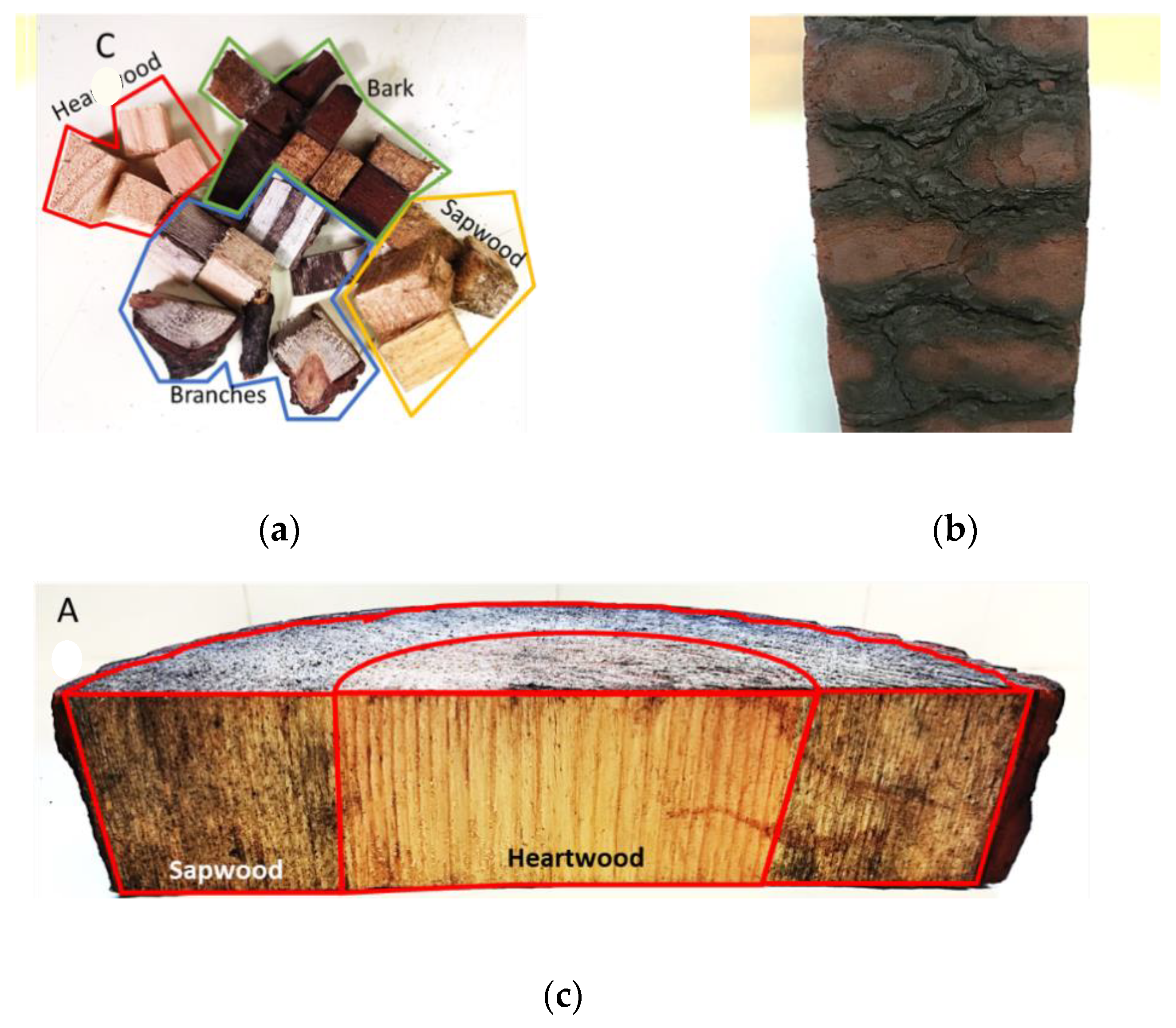
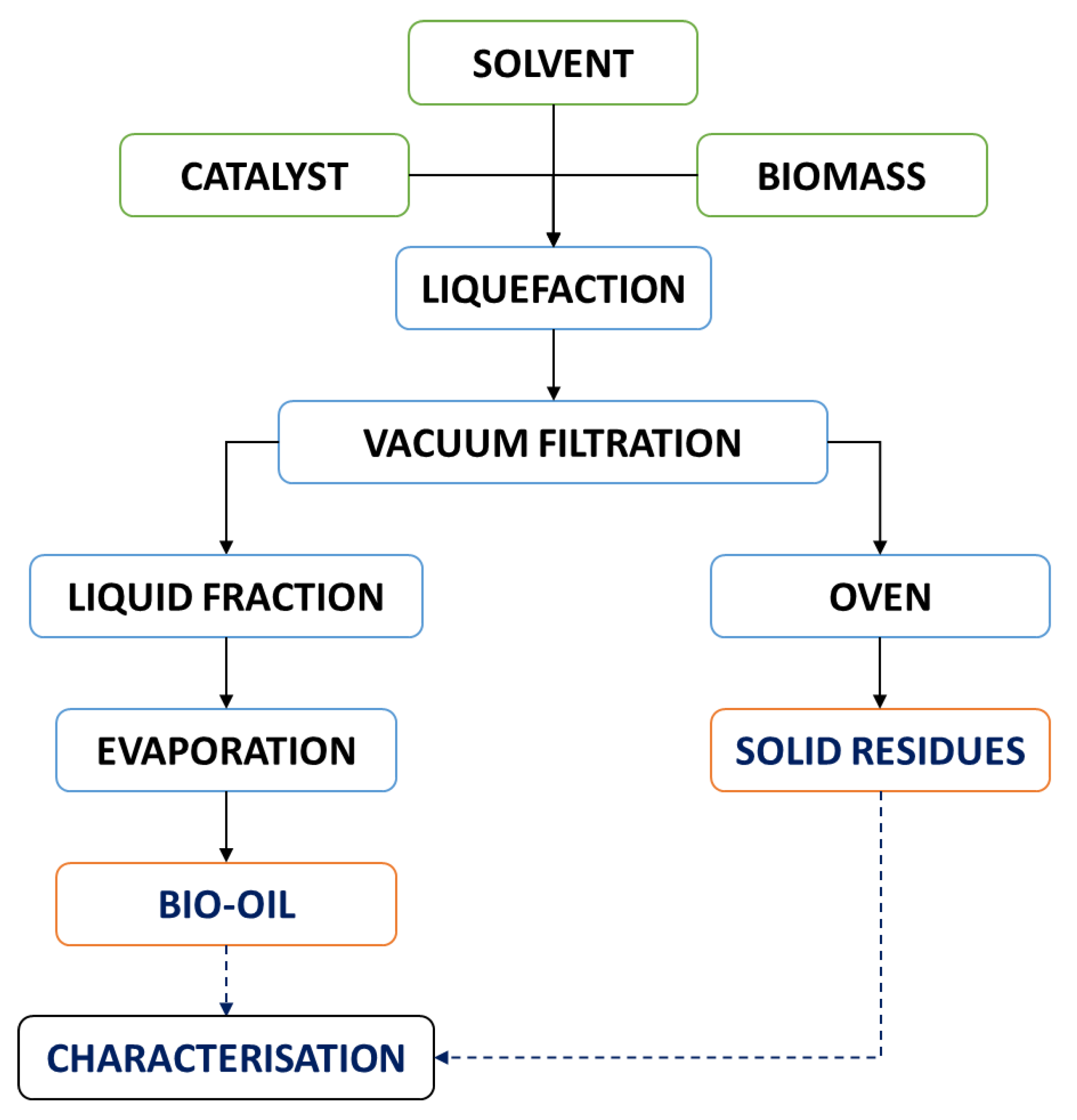
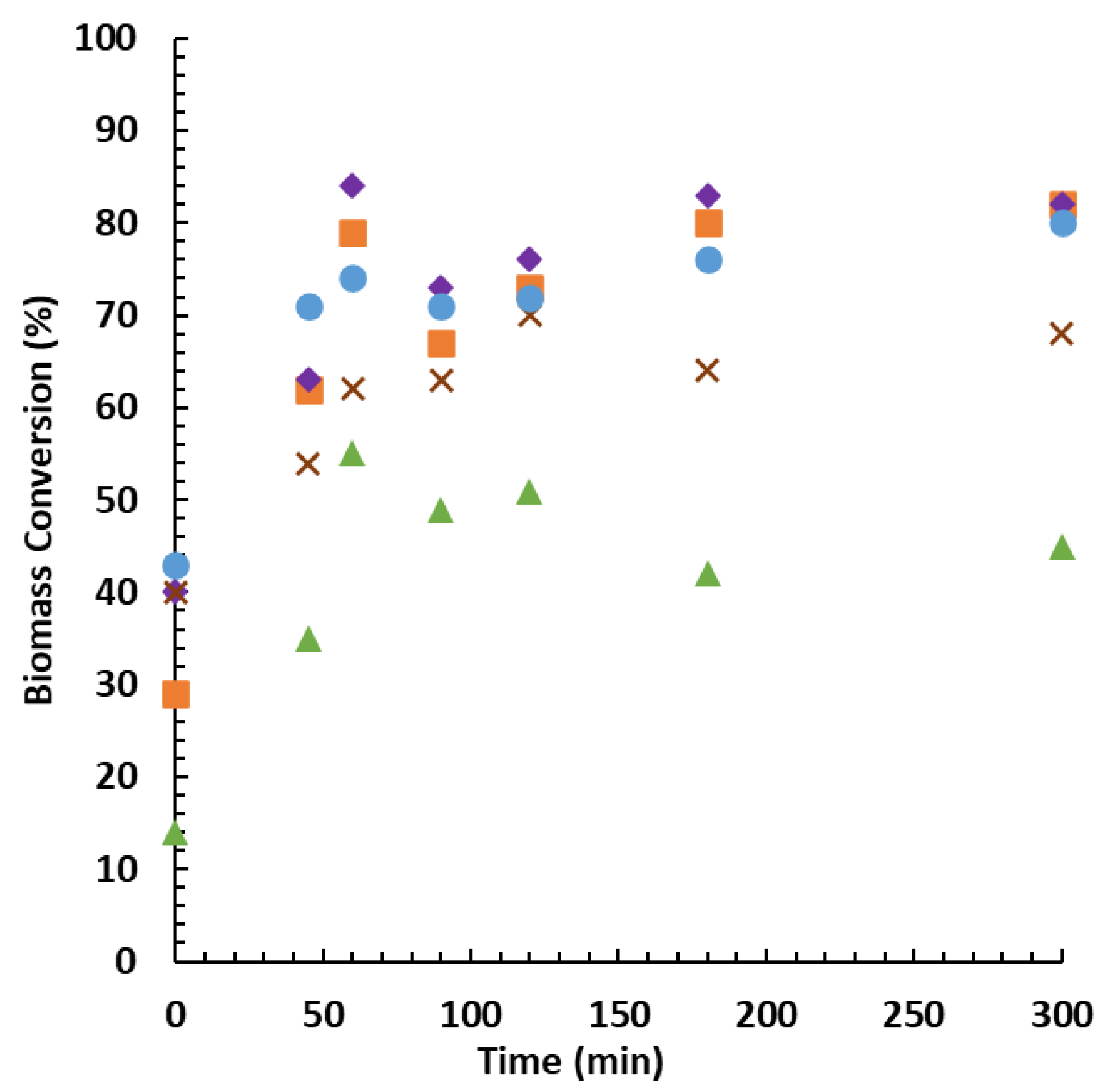
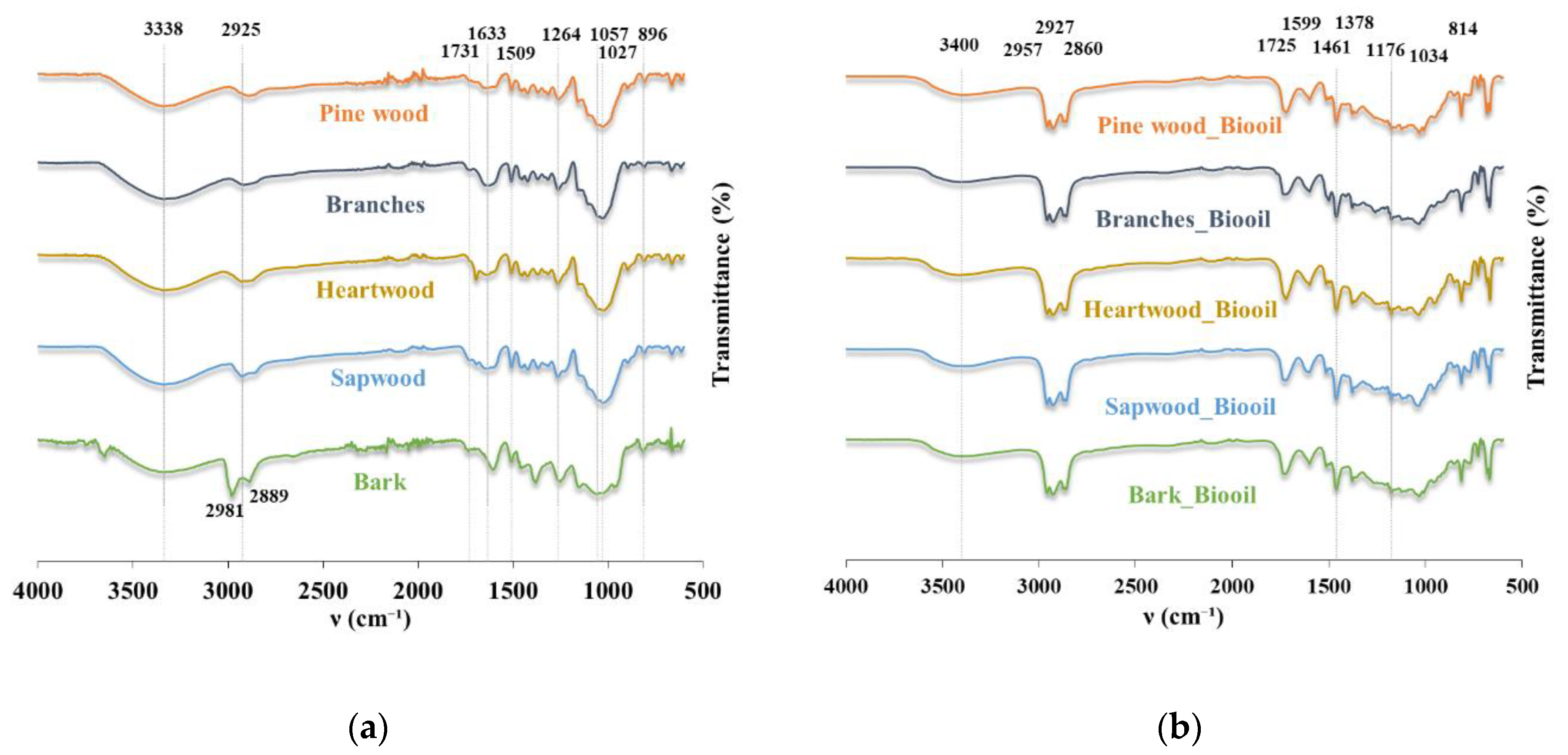
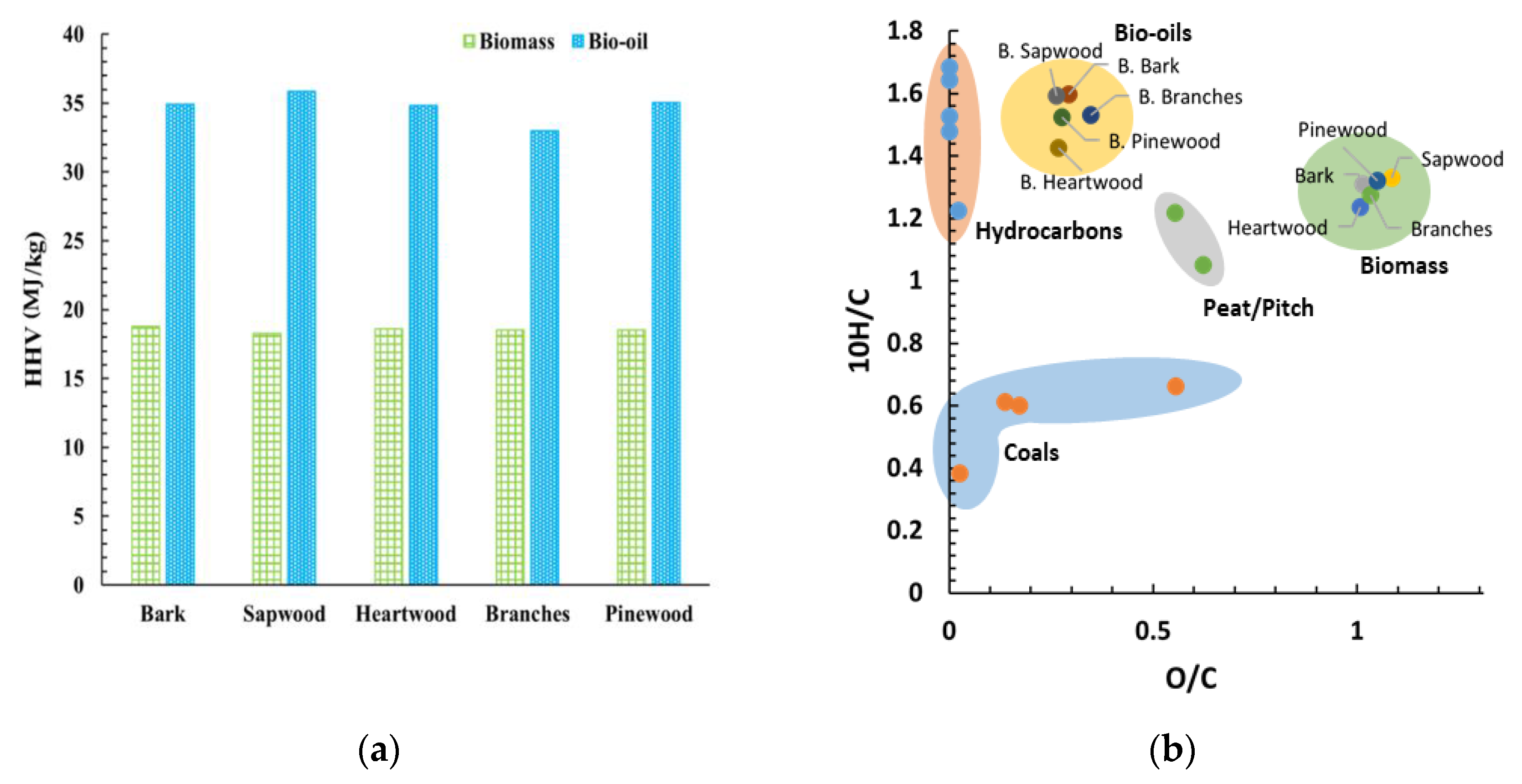
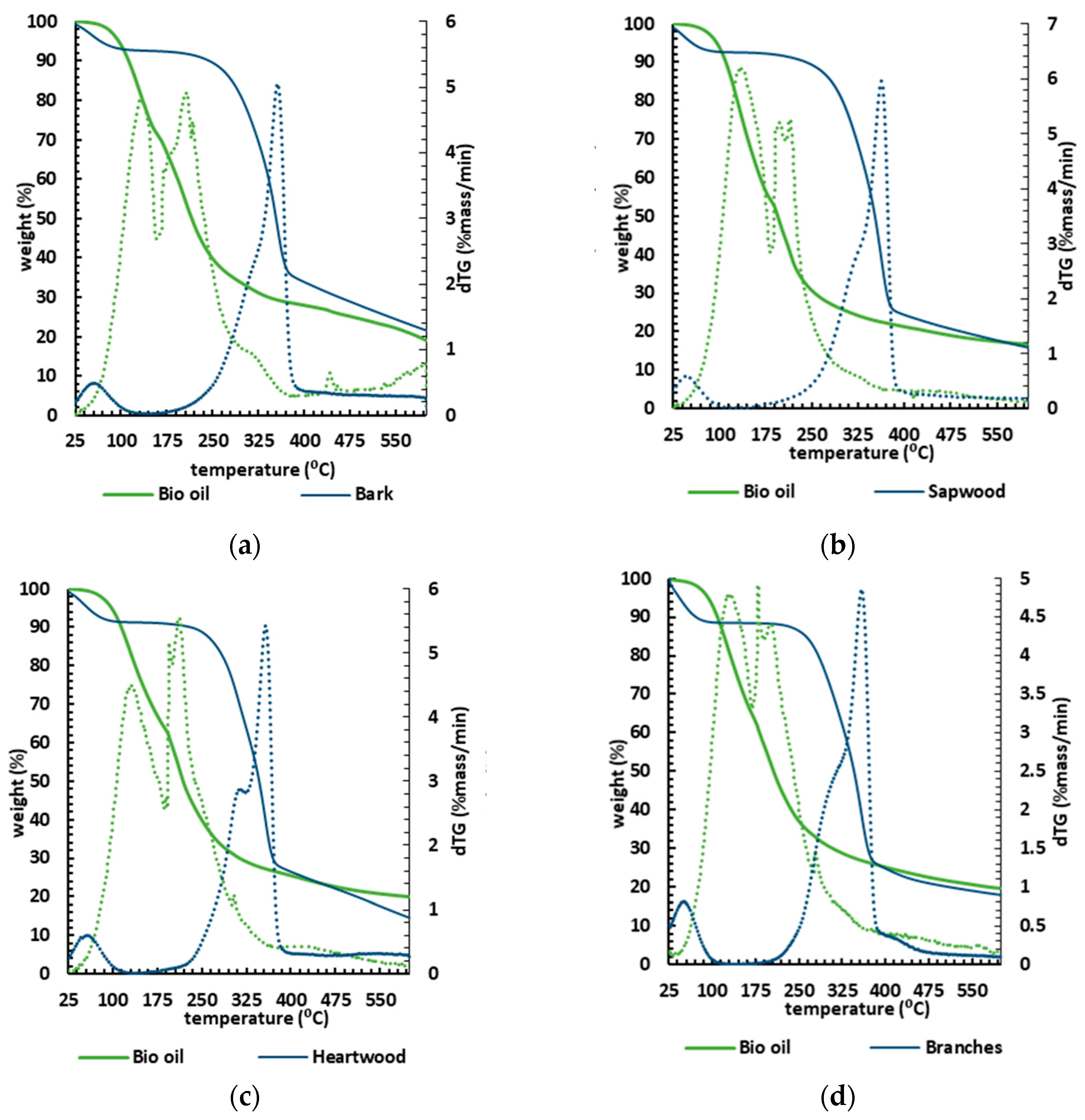
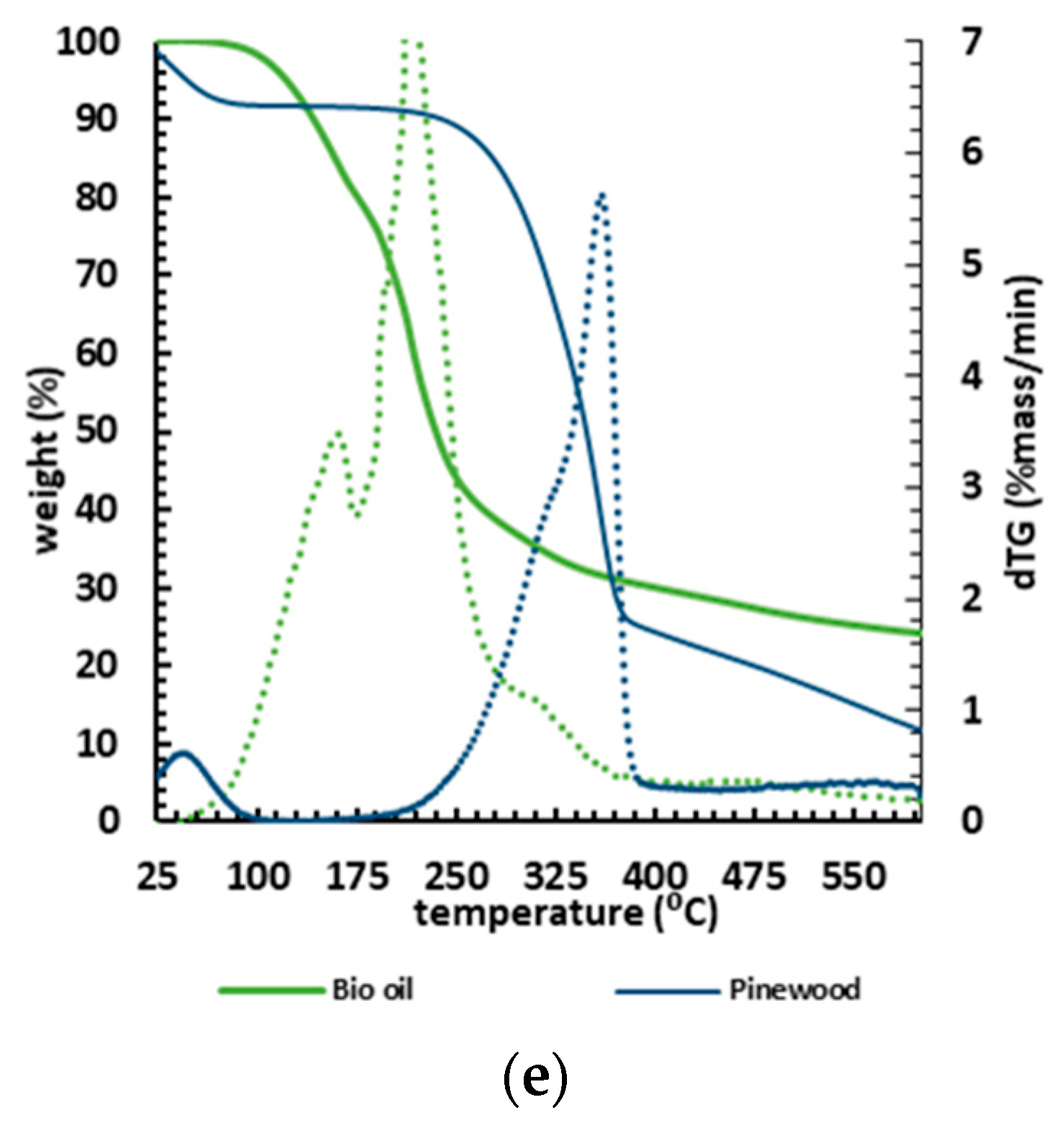
| Sample | Moisture * (%) | Elemental Analysis (%) | HHV (MJ/kg) | O/C | 10H/C | |||||
|---|---|---|---|---|---|---|---|---|---|---|
| S | C | H | N | O | ||||||
| Biomass | Bark | 2.97 | <0.5 | 46.60 | 6.10 | <2.0 | 47.30 | 18.77 | 1.015 | 1.309 |
| Sapwood | 5.20 | <0.5 | 45.10 | 6.00 | <2.0 | 48.90 | 18.25 | 1.084 | 1.330 | |
| Heartwood | 14.70 | <0.5 | 46.90 | 5.80 | <2.0 | 47.30 | 18.62 | 1.009 | 1.237 | |
| Branches | 25.18 | <0.5 | 46.30 | 5.90 | <2.0 | 47.80 | 18.52 | 1.032 | 1.274 | |
| Pinewood | 12.00 | <0.5 | 45.83 | 6.05 | <2.0 | 48.12 | 18.51 | 1.050 | 1.320 | |
| Wavenumber (cm−1) | Band Assignment | Compound/Group | Ref. | |
|---|---|---|---|---|
| Biomass | Bio-Oil | |||
| 3338 | 3400 | OH stretching | hydroxyl groups | [64] |
| 2981 2925 2889 | 2957 2957 2860 | CH2−, CH3− stretching | methylene and methyl groups from holocellulose and lignin | [9] |
| 1731 | 1725 | C=O stretching | ketones and esters | [54] |
| 1633 | -- | OH bending | water | [65,66] |
| 1599 | 1599 | C=C stretching | aromatic ring | [64] |
| 1461 | 1461 | OCH3–, –CH2–, C−H | carbohydrates | [67] |
| 1369 | 1378 | aromatic C–H deformation | syringyl rings (from lignin) | [54] |
| 1264 | -- | guaycyl rings | [68] | |
| -- | 1176 | aromatic ring vibration | cellulose | [69] |
| 1027 | 1034 | C−O−C asymmetric stretching | cellulose, hemicellulose, lignin | [68] |
| 896 | -- | C−O, C=C, and C−C−O | hemicellulose | [68] |
| -- | 814 | stretching | carbohydrates | [30] |
| Sample | Moisture * (%) | Elemental Analysis (%) | HHV (MJ/kg) | O/C | 10H/C | EDR * (%) | |||||
|---|---|---|---|---|---|---|---|---|---|---|---|
| S | C | H | N | O | |||||||
| Bio-oils | Bark | 0.96 | <0.5 | 68.79 | 10.99 | <2.0 | 20.22 | 34.90 | 0.294 | 1.598 | 1.86 |
| Sapwood | 0.98 | <0.5 | 70.30 | 11.20 | <2.0 | 18.50 | 35.85 | 0.263 | 1.593 | 1.96 | |
| Heartwood | 0.86 | <0.5 | 70.90 | 10.10 | <2.0 | 19.00 | 34.82 | 0.268 | 1.425 | 1.87 | |
| Branches | 0.84 | <0.5 | 66.65 | 10.20 | <2.0 | 23.15 | 32.96 | 0.347 | 1.530 | 1.78 | |
| Pinewood | 0.51 | <0.5 | 69.95 | 10.66 | <2.0 | 19.39 | 35.04 | 0.277 | 1.524 | 1.89 | |
| Coals | Anthracite [70] | -- | 0.83 | 91.60 | 3.50 | 1.60 | 2.39 | 35.63 | 0.026 | 0.382 | -- |
| Lignite [70] | -- | 0.61 | 60.51 | 4.01 | 1.22 | 33.66 | 21.52 | 0.556 | 0.663 | -- | |
| Bituminous coal [70] | -- | 0.43 | 81.80 | 5.00 | 1.50 | 11.21 | 33.69 | 0.137 | 0.611 | -- | |
| Coal [70] | -- | 0.41 | 78.31 | 4.71 | 2.30 | 13.50 | 30.86 | 0.172 | 0.601 | -- | |
| Hydrocarbons | Kerosene [70] | -- | 0.10 | 85.80 | 14.10 | 0.00 | 0.00 | 46.50 | 0.000 | 1.643 | -- |
| Gasoline [70] | -- | 0.10 | 85.50 | 14.40 | 0.00 | 0.00 | 46.88 | 0.000 | 1.684 | -- | |
| Fuel oil 6 [70] | -- | 0.05 | 85.70 | 10.50 | 1.70 | 2.00 | 42.30 | 0.023 | 1.225 | -- | |
| Fuel oil 2 [70] | -- | 0.00 | 87.30 | 12.90 | 0.00 | 0.01 | 43.80 | 0.000 | 1.478 | -- | |
| Diesel [70] | -- | 0.30 | 86.50 | 13.20 | 0.00 | 0.00 | 45.70 | 0.000 | 1.526 | -- | |
| Pitch [70] | -- | 0.00 | 59.67 | 7.27 | 0.00 | 33.05 | 26.70 | 0.554 | 1.218 | -- | |
| Peat [70] | -- | 0.17 | 56.88 | 5.98 | 1.53 | 35.38 | 22.65 | 0.622 | 1.051 | -- | |
| 1st Stage | 2nd Stage | 3rd Stage | 4th Stage | ||||||
|---|---|---|---|---|---|---|---|---|---|
| Sample | Temp. Range (°C) | Mass Loss (%) | Temp. Range (°C) | Mass Loss (%) | Temp. Range (°C) | Mass Loss (%) | Temp. Range (°C) | Mass Loss (%) | |
| Biomass | Bark | 25–135 | 7 | 160–340 | 31 | 340–400 | 27 | 400–600 | 12 |
| Sapwood | 7 | 33 | 35 | 8 | |||||
| Heartwood | 8 | 28 | 28 | 12 | |||||
| Branches | 12 | 28 | 29 | 7 | |||||
| Pinewood | 8 | 32 | 32 | 13 | |||||
| Bio-oil | Bark | 50–162 | 30 | 162–300 | 37 | 300–600 | 14 | --- | --- |
| Sapwood | 50–185 | 47 | 185–300 | 28 | 9 | ||||
| Heartwood | 50–185 | 35 | 185–300 | 34 | 11 | ||||
| Branches | 50–170 | 36 | 170–300 | 34 | 10 | ||||
| Pinewood | 50–185 | 23 | 170–300 | 41 | 12 | ||||
Publisher’s Note: MDPI stays neutral with regard to jurisdictional claims in published maps and institutional affiliations. |
© 2021 by the authors. Licensee MDPI, Basel, Switzerland. This article is an open access article distributed under the terms and conditions of the Creative Commons Attribution (CC BY) license (https://creativecommons.org/licenses/by/4.0/).
Share and Cite
Goncalves, D.; Orišková, S.; Matos, S.; Machado, H.; Vieira, S.; Bastos, D.; Gaspar, D.; Paiva, R.; Bordado, J.C.; Rodrigues, A.; et al. Thermochemical Liquefaction as a Cleaner and Efficient Route for Valuing Pinewood Residues from Forest Fires. Molecules 2021, 26, 7156. https://doi.org/10.3390/molecules26237156
Goncalves D, Orišková S, Matos S, Machado H, Vieira S, Bastos D, Gaspar D, Paiva R, Bordado JC, Rodrigues A, et al. Thermochemical Liquefaction as a Cleaner and Efficient Route for Valuing Pinewood Residues from Forest Fires. Molecules. 2021; 26(23):7156. https://doi.org/10.3390/molecules26237156
Chicago/Turabian StyleGoncalves, Diogo, Sofia Orišková, Sandro Matos, Henrique Machado, Salomé Vieira, David Bastos, Daniela Gaspar, Ricardo Paiva, João Carlos Bordado, Abel Rodrigues, and et al. 2021. "Thermochemical Liquefaction as a Cleaner and Efficient Route for Valuing Pinewood Residues from Forest Fires" Molecules 26, no. 23: 7156. https://doi.org/10.3390/molecules26237156
APA StyleGoncalves, D., Orišková, S., Matos, S., Machado, H., Vieira, S., Bastos, D., Gaspar, D., Paiva, R., Bordado, J. C., Rodrigues, A., & Galhano dos Santos, R. (2021). Thermochemical Liquefaction as a Cleaner and Efficient Route for Valuing Pinewood Residues from Forest Fires. Molecules, 26(23), 7156. https://doi.org/10.3390/molecules26237156










